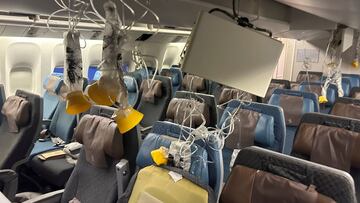AIRLINES
Cause of death of man in Singapore severe turbulence flight revealed
Tragedy struck this week when a 73-year-old man died aboard a Singapore Airlines flight following a harrowing experience caused by turbulence.

A tragic incident unfolded aboard a Singapore Airlines flight, initially en route from London to Singapore, when severe turbulence led to the death of a 73-year-old British passenger and injuries to dozens of others. The Boeing 777-300ER aircraft, which encountered the turbulence over the Irrawaddy Basin in Myanmar, was forced to make an emergency landing in Bangkok.
How did turbulence cause death of British man?
Passengers described the harrowing experience as the turbulence flung people across the cabin, causing many to hit the ceiling. Dzafran Azmir, a 28-year-old student on board, recounted the chaotic scene: “I saw people from across the aisle going completely horizontal, hitting the ceiling and landing back down in really awkward positions. People were getting massive gashes in the head, concussions.”
Photographs from the plane revealed significant damage, with gashes in the overhead panels, oxygen masks hanging, and luggage scattered. Some passengers’ heads slammed into the lights above the seats, breaking the panels.
The deceased passenger, believed to have suffered a heart attack, was among 211 passengers and 18 crew members on the original flight. At least 30 people were reported injured, though Samitivej Hospital in Thailand stated it was treating 71 passengers.
Singapore Airlines quickly organized a relief flight, transporting 131 passengers and 12 crew from Bangkok to Singapore, arriving just before 5 a.m. local time. Injured passengers and their families remained in Bangkok for medical attention.
Did you know? How turbulence is formed and why it is dangerous
Singapore Airlines CEO Goh Choon Phong expressed condolences: “On behalf of Singapore Airlines, I would like to express my deepest condolences to the family and loved ones of the deceased.” He explained that the pilot declared a medical emergency following the sudden turbulence and diverted to Bangkok.
Singapore’s Transport Safety Investigation Bureau dispatched officers to Bangkok to assist with the investigation. Given that the incident involved a U.S.-manufactured aircraft, the U.S. National Transportation Safety Board (NTSB) is also participating, sending an accredited representative and technical advisers.
The turbulence, described as a “rapid change in vertical rate” by FlightRadar24, occurred in an area with severe thunderstorms. AccuWeather attributed the violent turbulence to strong updrafts from rapidly developing thunderstorms near the flight path.
An airline pilot familiar with the region noted that turbulence is not uncommon in the Bay of Bengal area due to unstable weather patterns. Sara Nelson, international president of the Association of Flight Attendants-CWA, emphasized the importance of wearing seatbelts at all times, calling it “a matter of life and death.”
A 2021 NTSB study highlighted that turbulence-related incidents are the most common type of airline accidents, often resulting in serious injuries. From 2009 to 2018, turbulence accounted for over a third of reported airline accidents, though most did not result in aircraft damage.
Despite the severity of this incident, Singapore Airlines has maintained a strong safety record, with its last major accident occurring in 2000. The airline’s shares were not trading on Wednesday due to a public holiday in Singapore.





